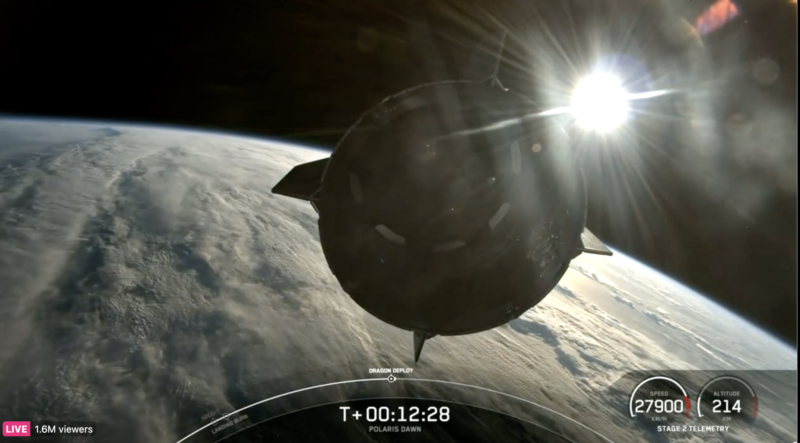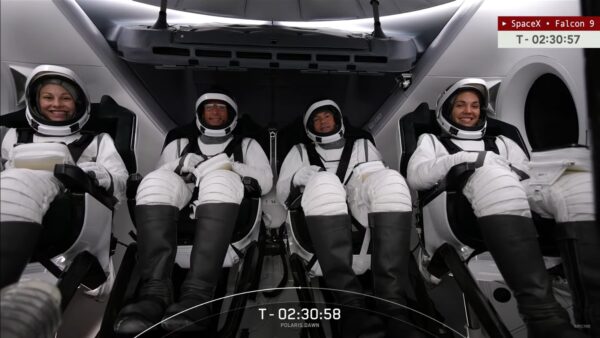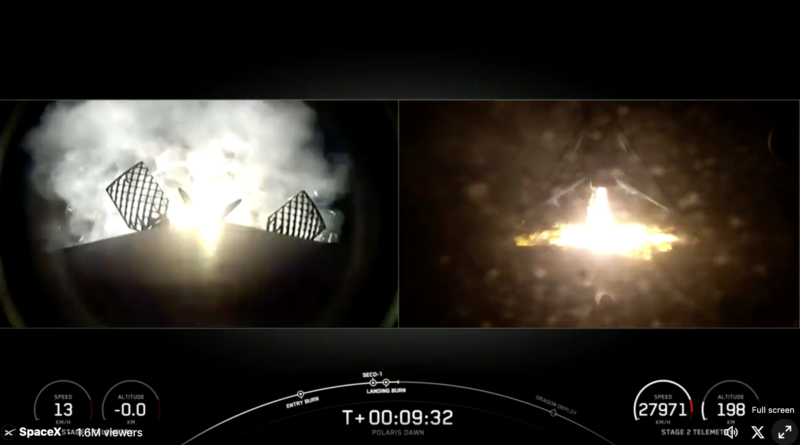Dragon and the Polaris Dawn crew splash down off the coast of Florida, completing the @PolarisProgram's first human spaceflight mission pic.twitter.com/Sobt66zxnL
— SpaceX (@SpaceX) September 15, 2024
Splashdown! A successful flight
Polaris Dawn returned to Earth on Sunday morning, September 15, 2024, with a splashdown near the Dry Tortugas of Florida. The civilian crew of four successfully completed a historic mission that included humans venturing the farthest from Earth since the Apollo missions and the first private spacewalk. See their return to Earth below and read more about the mission.
Dragon and the Polaris Dawn crew returning to Earth pic.twitter.com/p8hpwuT7lP
— SpaceX (@SpaceX) September 15, 2024
Splashdown of Dragon confirmed! Welcome back to Earth, @rookisaacman, @kiddpoteet, @Gillis_SarahE, @annawmenon pic.twitter.com/nILpMQh2sR
— SpaceX (@SpaceX) September 15, 2024
Dragon's hatch is open and the Polaris Dawn crew is getting ready to exit the spacecraft pic.twitter.com/KItVBSwJff
— SpaceX (@SpaceX) September 15, 2024
Music from Polaris Dawn
Crew member and violinist Sarah Gillis played her instrument from space while an orchestra of student musicians worldwide performed from Earth. Enjoy this musical moment – in support of St. Jude Children’s Hospital and ElSistemaUSA music education for children – in the player below. The piece is called Harmony of Resilience.
HARMONY OF RESILIENCE: Recorded in space and sent to Earth via @SpaceX’s @Starlink constellation, Polaris Dawn crewmember and violinist @Gillis_SarahE invites you to enjoy this music moment in support of @StJude & @ElSistemaUSA ? https://t.co/My8cUwAWzg pic.twitter.com/OoxTllCZNP
— Polaris (@PolarisProgram) September 13, 2024
Click play above to hear Sarah Gillis play her violin from space.
Polaris Dawn astronauts completed first civilian spacewalk
Early on Thursday, September 12, 2024, billionaire Jared Isaacman and SpaceX crew trainer Sarah Gillis took turns climbing outside Polaris Dawn’s Dragon spacecraft in the 1st civilian spacewalk in history. The two astronauts spent most of their time outside the capsule conducting mobility tests on their extravehicular activity (EVA) spacesuits, newly designed by SpaceX. These tests were static; at no point did they float freely away from the capsule. Gillis’s turn took place while the craft soared over the night side of Earth, but Isaacman – and those watching the livestream – got a stunning view of our planet’s lit side. As he peered at Earth, Isaacman said:
Back at home we all have a lot of work to do, but from here it sure looks like a perfect world.
Watch a replay of the spacewalk below.
It featured the 1st EVA by a private astronaut
The Dragon capsule settled at an orbit of 435 miles (700 km) above Earth (almost twice as high as the International Space Station). While Dragon was orbiting at that height, Isaacman and Gillis completed the first civilian spacewalk, or extravehicular activity.
They wore new SpaceX-designed EVA spacesuits, which were unveiled in May. The team announced the completion of their spacesuit testing on July 18.
The Polaris Dawn crew recently completed a series of spacesuit acceptance tests in preparation for the mission’s extravehicular activity, or spacewalk, marking the final significant developmental and test milestone for SpaceX’s newly-developed EVA spacesuit ?… pic.twitter.com/SOK0ImGir2
— Polaris (@PolarisProgram) July 18, 2024
No airlock for Polaris Dawn. Spacesuits on, everybody!
By the way, the Dragon space capsule doesn’t have an airlock. And instead of the cupola window, the ship was transformed with a nose hatch called a skywalker. When the hatch swings open, all the astronauts and the interior of the capsule are exposed to the vacuum of space.
Though wearing their spacesuits, Scott Poteet and Anna Menon stayed within the vehicle. The other two performed the spacewalk. This broke the record for the most people in the vacuum of space at once.
Also, the mission has used SpaceX’s Starlink laser-based communications. This is how we got to see that beautiful violin performance from Sarah Gillis.
Farthest humans in space since Apollo
On September 10, 2024, Polaris Dawn launched into space with 4 civilian astronauts aboard. Then, later in the day, the Dragon spacecraft set a record by reaching an apogee – or most distant point from Earth – of 870.3 miles (1,400.7 km). It occurred on the spacecraft’s 8th orbit of Earth and marked the farthest humans have been from Earth since the Apollo moon missions of the late 1960s and early ’70s.
Polaris Dawn and Dragon at 1,400 km above Earth – the farthest humans have traveled since the Apollo program over 50 years ago pic.twitter.com/rRDeD1dY1e
— SpaceX (@SpaceX) September 11, 2024
Polaris Dawn Flight Day 1 Update
The Polaris Dawn crew completed their first day on-orbit, also known as Flight Day 1. After a successful launch by SpaceX’s Falcon 9 rocket to low-Earth orbit from Launch Complex 39A at NASA’s Kennedy Space Center in Florida at 5:23 a.m. ET, the… pic.twitter.com/pcmEF5k2S3
— Polaris (@PolarisProgram) September 10, 2024
Also, after the launch of three astronauts headed toward the space station on Wednesday, we set a new record for the number of humans in space, with 19.
A new record has been set for the most people in Earth orbit at one time: 19
International Space Station:
Matthew Dominick
Michael Barratt
Jeanette Epps
Alexander Grebenkin
Oleg Kononenko
Tracy Caldwell Dyson
Nikolai Chub
Butch Wilmore
Suni WilliamsSoyuz MS-26, en route to…
— John Kraus (@johnkrausphotos) September 11, 2024
Polaris Dawn launched September 10
The all-civilian Polaris Dawn mission had an original target launch date of July 31, 2024. It faced numerous delays, mostly due to an exploding SpaceX Falcon 9 booster (which grounded the Falcon 9 for a time) and unfavorable weather. But the mission finally launched successfully on September 10, 2024.
The four astronauts on board were giving thumbs up and appearing happy as Polaris Dawn roared into orbit at 5:23 a.m. EDT (9:23 UTC) from historic Launch Complex-39A at NASA’s Kennedy Space Center in Florida. That launch complex was the site of many Apollo moon mission launches in the late 1960s and early ’70s. And those Apollo missions – some 50 years ago – were the last crewed missions to fly as high as Polaris Dawn did this week.
Polaris Dawn went more than twice as high this week as the International Space Station. And it featured the 1st extravehicular activity, or spacewalk, by a private astronaut.



Polaris Dawn mission backer is riding along
This is the first mission of the Polaris Program, a planned private spaceflight program. The crew consists entirely of civilians. The astronauts are riding aboard Crew Dragon Resilience, manufactured by SpaceX and built under NASA’s Commercial Crew Program.
Entrepreneur Jared Isaacman organized the mission, and he is one of the crew members. In addition to Isaacman, the crew consists of Scott Poteet, Sarah Gillis and Anna Menon. You might remember Jared Isaacman if you watched Netflix’s Countdown: Inspiration4 Mission to Space. Mission commander Isaacman led the first all-civilian mission to space in 2021, spending three days orbiting Earth.
Isaacman, who reportedly made billions in a payment processing company he started in his teens, is financially backing Polaris Dawn. He also backed the Inspiration4 mission.
Poteet is a retired U.S. Air Force pilot, while Gillis and Menon are engineers from SpaceX.
And just as Inspiration4 did, the Polaris Dawn mission is fundraising for the St. Jude Children’s Hospital in Memphis, Tennessee, which is dedicated to fighting childhood cancer.
Polaris Dawn in parts of the Van Allen belts
Polaris Dawn’s initial orbit was at a remarkable 870 miles (1,400 km) above Earth, about 3 1/2 times higher than the International Space Station.
That height sent Polaris Dawn through parts of the Van Allen radiation belts. There are typically two Van Allen belts, but the intense solar storms and subsequent geomagnetic storms of May 2024 spawned a third belt. There’s been no word as to whether the third belt is still up there (last time scientists recorded a third Van Allen Belt, it lasted only a month).
Either way, whether there are two belts or three, the mission plans to use the opportunity to study the effects of space radiation on human health. Watch a video about the possible third Van Allen Belt below.
Bottom line: The crew of Polaris Dawn is safely back on Earth after setting records including the farthest humans from Earth since Apollo and the first spacewalk by civilians.
Read more: List of SpaceX Starlink launches for September 2024











